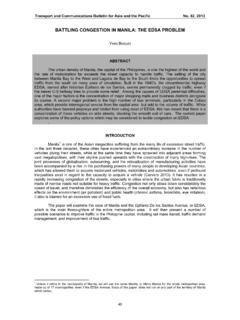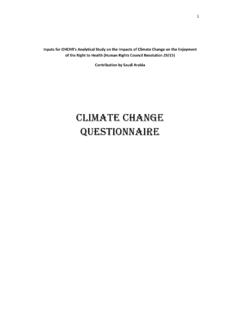Transcription of Question paper (A-level) : Paper 1 Markets and market ...
1 A-level ECONOMICS. Paper 1 Markets and market Failure Monday 20 May 2019 Morning Time allowed: 2 hours Materials For this Paper you must have: an AQA 12-page answer book a calculator. Instructions Use black ink or black ball-point pen. Pencil should only be used for drawing. Write the information required on the front cover of your answer book. The Paper Reference is 7136/1. In Section A answer EITHER Context 1 OR Context 2. In Section B, answer ONE essay. Information The marks for questions are shown in brackets. The maximum mark for this Paper is 80. There are 40 marks for Section A and 40 marks for Section B. You will be marked on your ability to: use good English organise information clearly use specialist vocabulary where appropriate.
2 Advice You are advised to spend 1 hour on Section A and 1 hour on Section B. IB/M/Jun19/E11 7136/1. 2. Section A. Answer EITHER Context 1 OR Context 2. EITHER. Context 1 Total for this context: 40 marks The market for sand Study Extracts A, B and C, and then answer all parts of Context 1 which follow. Extract A. Figure 1: Indices of US producer prices for sand, Figure 2: Global demand for sand Jan 2010 Jan 2018 (Jan 2010=100) (millions of tons), 2010 2025. Source: Federal Reserve Economic Data, 2018 Source: The Freedonia Group/National Post, 2018. Extract B: Is the world running out of sand? Sand is in high demand. Sand accounts for up to 85% of all mining and the global depletion of sand is rapidly exceeding its natural renewal rate.
3 Sand is mostly used in the construction industry to make concrete and asphalt. Chinese demand has risen significantly, reflecting the country's rapid pace of construction: it built million houses and million kilometres of road between 2011 and 2014. Sand also has industrial uses: it is used to make glass, 5. electronics, and to help extract oil in the fracking industry. While market demand for industrial sand has tracked overall economic growth in the USA, the demand for fracking sand has been as volatile as oil prices. Vast quantities of sand are dumped into the sea to reclaim land: Singapore, for example, has expanded its land area by over 20% since the 1960s. Much of this sand originates from 10.
4 Indonesia, where sand miners have completely erased over 20 islands since 2005. The Maldives and Kiribati have used sand to shore up their islands against rising sea levels. The United Nations forecasts that, by 2030, there will be over 40 megacities', home to more than IB/M/Jun19/7136/1. 3. 10 million inhabitants (up from 31 in 2016), which means more housing and infrastructure will need to be built. Also, sea levels will continue to rise and so sand will only become more 15. sought after. But why is there a shortage when sand seems so abundant? Desert sand is too smooth, and so cannot be used for most commercial purposes. Australian sand was shipped to a faraway desert to build Dubai's Burj Khalifa tower, made possible by cheaper transportation.
5 Most countries have rules in place about where, and how much, sand can be mined. However, surging demand has sparked a lucrative illegal trade in many rapidly developing countries which 20. is damaging the environment, causing pollution and harming local biodiversity. Source: News reports, February 2018. Extract C: The need for international action There are currently no international conventions to regulate sand extraction, trade and use. Critics argue that the international community needs to treat sand like a resource on a par with clean air, biodiversity and other natural endowments that nations seek to manage for the future. In the developed world, concerns have led to restrictions on where sand can be mined.
6 In the USA, for example, mining it offshore or near large residential areas is restricted. Regulations 5. are also in place in many developing countries. Indonesia, Malaysia and Cambodia have all placed restrictions on exports, although the rules are not always enforced. There is a particular problem of ineffective enforcement in India, with organised criminal networks ignoring rules and conducting unregulated sand mining. Substitutes for sand do exist. Mud can be used for land reclamation, straw and wood for 10. building houses, and crushed rock for making concrete. In some rich countries a shift towards these alternative production processes is already under way as sand prices rise.
7 In the UK, sand demand is 25% less than in 2007, and 28% of building materials used in the UK in 2014. had been recycled. Rising prices will eventually also force builders in developing countries to explore alternatives to sand. But without better law enforcement, high sand prices also make 15. illegal mining more profitable. Source: News reports, February 2018. 0 1 Using the data in Extract A (Figure 1), calculate the percentage change in the price of construction sand between January 2014 and January 2018. Give your answer correct to one decimal place. [2 marks]. 0 2 Explain how the data in Extract A (Figures 1 and 2) show that expansion in the global sand market is leading to prices of construction sand rising in real terms.
8 [4 marks]. 0 3 Extract B (line 18) states that the global trade in sand has been made possible by cheaper transportation'. With the help of a diagram, explain how cheaper transportation and a construction boom in East Asia have led to growth in the market for sand. [9 marks]. 0 4 Extract C (lines 14 15) states that Rising prices will eventually also force builders in developing countries to explore alternatives to sand.'. Use the extracts and your knowledge of economics to assess the view that the increasing scarcity of sand is a problem best solved by market forces, rather than through government intervention. [25 marks]. Turn over . IB/M/Jun19/7136/1. 4. Do NOT answer Context 2 if you have answered Context 1.
9 OR. Context 2 Total for this context: 40 marks The British railway system Study Extracts D, E and F and then answer all parts of Context 2 which follow. Extract D. Figure 3: UK (excluding Northern Ireland) Figure 4: Indices of UK rail ticket prices and rail industry income, 2010 2016 passenger kilometres, 2004 2017. (2004=100). millions 2010 11 2015 16. Passenger 7 588 9 160. income Government 6 182 6 697. funding Network Rail 2 565 2 300. income Other income 793 833. Total 17 128 18 990. Passenger income as % 44% 48%. of total Source: Office of Rail and Road, Feb 2017. Extract E: Privatisation of British Rail More competition, greater efficiency and a wider choice of services', proclaimed the 1992.
10 Government white Paper that advocated the privatisation of British Rail. Two decades on, passenger journeys have more than doubled from 735 million in 1994 5, to in 2016 17. But how much of this is due to the benefits of privatisation, rather than factors such as increasing urban congestion and a rising population? The UK's trains and tracks are more 5. intensively used than in any other European market except the Netherlands. Investment is up, at around four times (in real terms) the a year it averaged in the late 1980s. The data on service quality are mixed. The UK performs well in terms of punctuality and reliability, but many journeys are uncomfortable. At peak hours 23% of London commuters have to stand.












